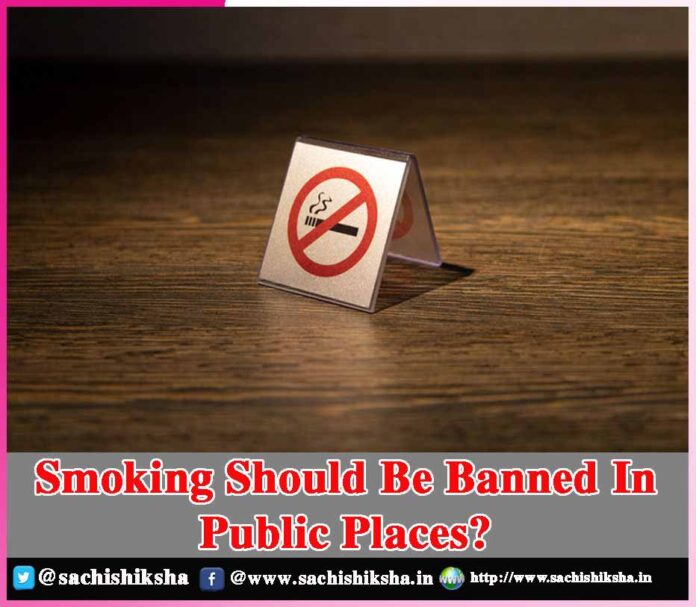Smoking Should Be Banned In Public Places?
Tobacco was used by Native Americans in religious ceremonies and for medical purposes. With the arrival of the European the consumption, cultivation, and trading of tobacco quickly spread.
By 1600 tobacco use had spread across Europe and England and was also being used as a monetary standard, a practice that continued throughout the following century. Cigarettes making machines were developed in the latter half of the 1800s. The first such machines produced about 200 cigarettes per minute.
Today’s machines produce about 9000 per minute. Cheap mass production and the use of cigarette advertising allowed tobacco companies to expand their markets during this period. Cigarettes were first introduced in the United States in the early 19th century. Before this, tobacco was used primarily in pipes and cigars by chewing and in snuff. Tobacco was first bought to India by Portuguese merchants 400 years ago.
Also Read :-
- World Cancer Day
- Prevention of Cancer Disease
- Say ‘NO’ to Drugs
- Do Not Destroy Your Life in Smokes
- Tips for Keeping Your Heart Healthy
- 5 Top Ways to Age Gracefully
Table of Contents
Smoking increased dramatically during the world wars,

There is a treasure trove of bogus old ads, viewable online, featuring claims by tobacco companies that cigarettes post no health risks, or even that they are beneficial in aiding digestion. This was the tobacco industry’s response to the research surfacing in the 1940s linking smoking to cancer. Their answer was to fund studies of their own to prove that tobacco smoking was safe.
The first successful lawsuits against tobacco
companies over smoking-related illness happened in the latter part of the 20th Century. By the 1960s the evidence against smoking was more than critical. In 1964, the U.S. Surgeon General released the first report on the health effects of smoking. After reviewing more than 7000 articles in the medical literature, the Surgeon General concluded that smoking caused lung cancer and bronchitis.
Further smoking causes heart diseases, lung diseases, diabetes, chronic obstructive pulmonary disease. Smoking also increases risk for tuberculosis, breathing problems, dental problems certain eye diseases and problems of the immune system, including rheumatoid arthritis. The younger you start smoking the more damage there will be to your body as an adult.
People who smoke in public portray a bad example.
Children are easily influenced in their growing stages. They imitate people around them because they cannot differentiate between right and wrong. Teenagers happen to think that smoking makes a person cool.
When they see adults doing it on the streets it strengthens their belief in the coolness of smoking. Some teenagers even think that smoking marks their transition into adulthood and maturity. Hence more teenagers start smoking due to the influence of seeing other people smoke in public places.
If smoking is banned in public
it safeguards the life of the smoker as well as that of the public. Second hand smoke causes sudden infant death syndrome (SIDS), respiratory infections and asthma attacks in children. Besides it can cause heart and lung diseases in non-smoking adults. According to the Centre for Disease Control (CDC), second hand smoke contains at least 250 chemicals known to be toxic, including more than 50 that can cause cancer. These studies have proven that second hand smoke can cause cancer and is extremely bad for both the smokers and non-smokers.
In addition, the CDC also states that second hand smoke exposure causes approximately 3,400 lung cancer deaths and 22,700-69,600 heart disease deaths annually among adult non smokers in the United States (CDC 2009). This means that just by being near people who are smoking, innocent people are dying of diseases that are caused by second hand smoke. This violates a non-smoker’s right to live a healthy lifestyle because just being in public places where other people smoke, they are subjected to breathing toxic fumes. The health of innocent non-smokers who are in public places are being jeopardized against their will.
Smoking is a personal choice
Smoking is a personal choice and a highly addictive habit. Smokers choose to subject themselves to the health risks of smoking, even after clear warnings on cigarettes packs and widespread information available about the dangers of smoking. It is not for the government or any third party to dictate whether or not a person should be allowed to smoke. However, smoking not only affects the smoker it also affects the people around them. When people smoke in public, the smoke travels everywhere through the air, and the negative effects of this smoke affects all living, breathing creatures. Therefore, smoking should be banned in all public places.
By putting forth the ban of smoking in public places the government is promoting a healthier lifestyle and it protects every citizen from many diseases and health risks. The ban will eliminate the bad example set by people smoking in the public. Banning smoking will help children and teenagers develop a mindset that smoking is bad. The ban will discourage non-smokers from starting to smoke. It will also encourage smokers to quit and aid them on the difficult journey to be freed from the bonds of addiction. The ban will further help environment with no cigarette’s ends littered all over the place affecting the environment negatively. By prohibiting people from smoking in public the government is protecting the rights to live a full and healthy life.
Laws pertaining to where people may smoke
Laws pertaining to where people may smoke vary around the world. China and the United States two of five permanent members of the United Nations Security Council do not have nationwide smoking ban covering all public indoor areas, while the remaining three members France, Russia and the United Kingdom, all have national laws prohibiting smoking in many indoor spaces. In India a nationwide smoke-free law pertaining to public places came into effect from 2nd October 2008. The Cable Television Network (Regulation) Amendment Bill, in force since 8th September 2000, completely prohibits cigarettes and alcohol advertisements.
Public smoking
Public smoking was made illegal in the history of the world first by a Division Bench in Kerala High Court in 1991. The first city to become smoke free was Chandigarh. According to the report published by the medical journal “The Lancet” around 11% death in the world are caused due to smoking. The majority of people are dying out of smoking belong to China, Russia, India and USA. Smoking is the second largest reason for early death and disability so it is a major point of concern for all the countries across the globe.
















































